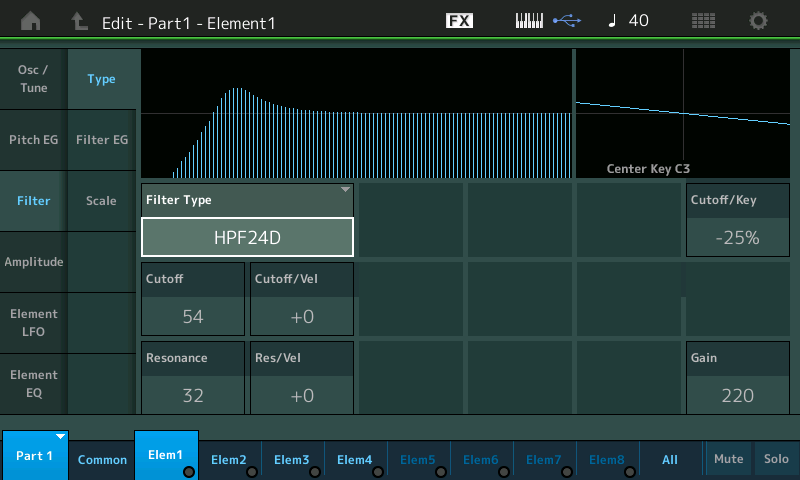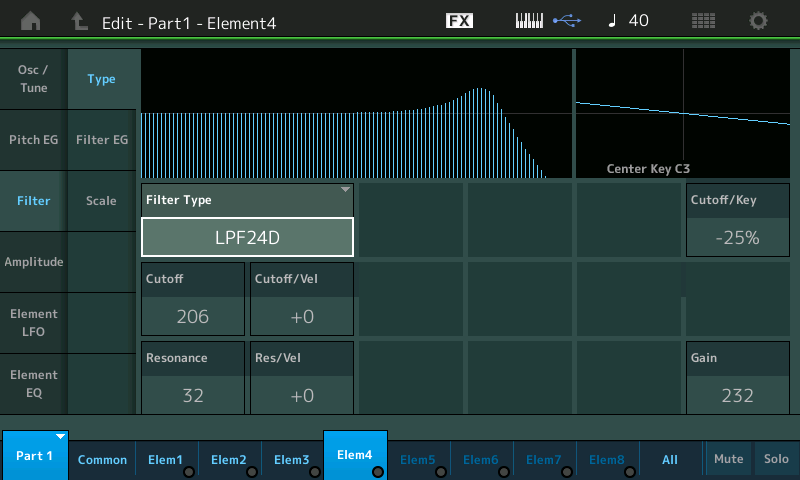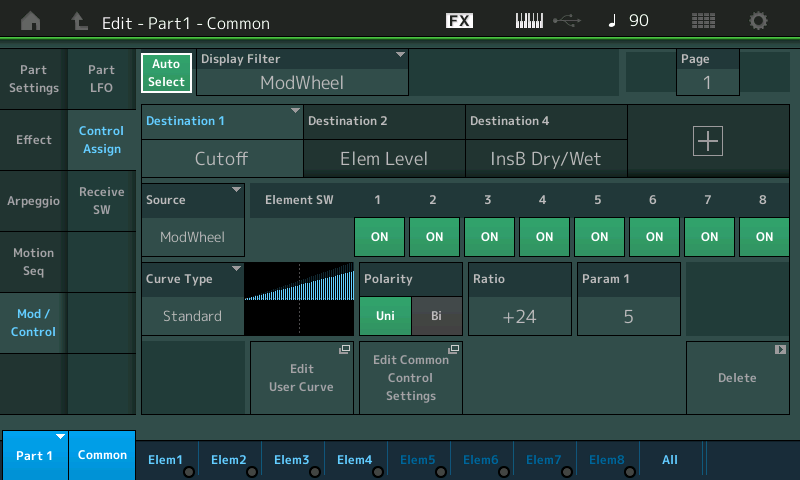I am having difficulty relating these physical controls to anything I can see in the screens for Common Edit, Part Edit or Element Edit.
I am working with an AWM2 Part Synth Brass 2
I have experimented with Filter Cutoff and Resonance for individual elements. There is an on screen graphical representation, with a Filter Type, Cutoff and Resonance parameters.
If I turn the physical Cutoff or Resonance knob, nothing in the element screen changes, and a black "closed caption" screen appears at the top saying "Part 1 Cutoff ".
Also, the result of changing the element parameters on screen sounds nothing like changing the Physical Knob.
In the Home screen, moving the knob calls up a black closed caption saying "Common Cutoff" or "Common Resonance" respectively.
In either Common Edit, or Part Edit, I cannot find any screen relating to filter type, cutoff or resonance.
Question:
Are the Physical Cutoff and Resonance Control knobs, controlling some generic (non accessible, non visible) filter for each Part, and an overriding "common" filter for each Performance.?
Is the signal flow this
element1 --> Element1_filter ---> Part1_Filter ---> Common_Filter
element2 --> Element2_filter ---> Part1_Filter ---> Common_Filter
element3 --> Element3_filter ---> Part1_Filter ---> Common_Filter
Read BM's post:
https://www.yamahasynth.com/ask-a-question/assign-performance-common-cutoff-to-knob
... the part about the common cutoff/resonance applying an offset to every Part.
Current Yamaha Synthesizers: Montage Classic 7, Motif XF6, S90XS, MO6, EX5R
Thanks Jason.
I read the Post by BM.
I am still Confused.
Offset....
I can see in the Element EDIT, Filter SCALE tab, there are Cutoff Offset parameters for each of the defined keyboard sections.
I have not used this yet, but I understood the OFFSET value to be a direct addition or subtraction to the Cutoff Parameter value defined in the TYPE tab (the screen with graphical representation of the filter).
So, if the Element Cutoff value is 106, and the (Scale) Cutoff Offset is +15, the actual Cutoff value is 106+15=121.
This I assume lets you "bias" more or less Cutoff, depending on where you are playing on the keyboard.
Same with Cutoff/Velocity, same with Cutoff/Key.
Is the (Quick Edit Knob) Cutoff doing the same thing? i.e. just adding upto +/-64 to the Cutoff Value in Element Edit (Filter Type TAB).
Cutoff Value can be 0-255 according to the Reference Manual.
Say there were 3 elements in the part, with Cutoff values
Element 1 = 100
Element 2 = 120
Element 3 = 80
If the Quick Edit Cutoff Knob was turned to have a value of -15, would this make:-
element1 = 85
element2 = 105
element3 = 65
?
The Knob labeled Cutoff and Resonance are not a Filter, rather they are controls that, when applied, address any and all Filters under its jurisdiction. They apply an offset.
In other words, if the “Quick Edit” is set to target = “Common” when you turn the “Cutoff” and “Resonance” Knob this means that all Filters will be offset from their current settings. Adding to or subtracting from their current setting.
If, however, under the same circumstances, if no Parts have Filters assigned, the controls will offset nothing. These Knobs are offsets only.
AWM2 Normal Parts can have a Filter per Element (maximum of 8 Elements per Part). If an AWM2 Normal Part is designated as the target on the “Quick Edit” screen then each of its Element’s Filters will be offset. Please realize that some could be Low Pass Filters, some could be High Pass Filter, and others could be Dual Band Pass, etc.
AWM2 Drum Parts can have a Filter per Key (that’s right - drum kits are a collection of 73 instruments - each autonomous.
An FM-X Part sends the output result from all Carriers thru its Filter... much like an analog synth, FM has one filter through which all oscillators travel together. (FM-X uses the Modulator:Carrier tuning relationship to change Timbre/Tone of the resulting sound. But in this advanced version of FM you can apply a Filter to any FM sound. As an example, when you load in a legacy DX7 sound (which are compatible with FM-X) you discover that no Filter is ever applied (again, because the original FM engine did not have any Filters)... turning the “Quick Edit” Cutoff and Resonance Knobs will have absolutely no effect.
As we mentioned those Knobs are not a Filter, they are a control that can be used to offset any active Filter - if there is one to offset.
These Knobs (Cutoff and Resonance) send and respond to CC74 and CC71, respectively.
If you are playing a Multi Performance (AWM2 Normal) that like “Seattle Sevtions” which has 22 individual Filters, you could use the “Quick Edit” CUTOFF knob to open or close all 22 Filters simultaneously.
But by targeting Part 1 (the 1st Violins) turning that same CUTOFF Knob could be used to just brighten or darken that one Part.
Using the massive Control Assign matrix — each Part can have 16 Controller Assignment Sets — you could target just the Elements you wish to change... because the Assign Knobs can be set to control any Element grouping you desire.
Instead of painting with big broad strokes you can design control so that it suits your needs. The Common and Part Assign Knobs can control be made to address all Filters in a Part, or you can select exactly which Element’s Filters you which to control. This is the level of control that separates this engine from most other synths... moving an Assign Knob from 12 o’clock to 3 o’clock could be opening the Filters on Elements 1 and 3 (each differing amounts) while the same gesture could be closing the Filter on Element 2
AWM2- each Element has its own Filter
Select a Part > press [EDIT] > the active Elements will appear across the bottom of the screen.
Select “Elem1” - you can see it is equivalent to a complete analog synth in that it has an Oscillator (and PitchEG), a Filter (and FilterEG) an Amplitude Generator, (additionally it has its own routing option to the Insertion Effects), each has its on LFOs, and so on.

Above Elem1 has a High Pass Filter assigned
Below Elem4 of the same Part has a Low Pass Filter assigned

An Element Filter can be set to one of 18 Filter Types, it has its own detailed parameters that let you control how it responds to Velocity, how it responds across the key ranges, you can even scale that response as necessary etc., etc. (a reason this engine is a programmers dream!)

In the Part’s “Control Assign” area you can see how Controllers, called “Source”, can be set to control the CUTOFF “Destination”; in this example it’s a MW but could be any of your physical controllers or a Motion Seq. You can opt in or out using the Element Switches. Above all Element switches are On, but by setting one to OFF it would not respond to the MW movement. You could setup a separate Sorce/Destination Control Set if you so desired.
Just FYI: These are musical functions... which should be programmed “by ear”. When you are playing guitar and you are bending a string, do you calculate (or even care) how many cents sharp you bend the pitch? Or do you just bend the pitch by how you feel and the resulting sound. While I’m sure you can do the math and it would be very interesting from an academic view, but in reality - it’s not what you really care about, and certainly your audience does not care that you bent the pitch so any cents sharp... or that you opened the Wah-Wah pedal +45 units on a scale of 0-255. Programming is trial and error, and feel.
When you see 0 thru 127, or -64 thru 0 to +63, you are looking at the 128 steps of resolution given most functions in MIDI.
When you see actual scientific values like measured in +/-dB (deciBels) or in % units, you can rely on the actual values.
But like when changing Gate Time which goes + or - 100 units... it’s enough to know + is longer, and - is shorter duration. How much? Do it “by ear”
It’s the difference between being a good cook that does not have to measure every single item, is another analogy that applies.
With Offsets, you are concerned about direction and sonic results... it is standard that when offsetting... that there is minimum and maximum, if your offset value exceed the maximum, there will be no more increase. For example, adding a value that exceeds the maximum is as meaningless as turning down (subtracting) a value that reduces volume to a negative number.... once you reach minimum all volume values below zero are truly meaningless.
In general, its music — Trust your ears, not your eyes.
You're right about using your ears - and I was.
I was trying out various parts (Brass), with the song playing in the background. I was trying to match or find similarities by ear.
I noticed on some Parts, turning the Cutoff and Resonance knobs had quite a noticeable affect. But on others, it seemed to make very little difference. So, in those cases I drilled down to the element level and started playing with the filters, and I noticed, per element, there was a significant change.
Thats what made me think there were "governing" filters at the Part level, or common level. When I couldn't find them is when I wrote my initial post.
After Js response, pointing to your post, I started to wonder where/what offsets were. Moreover, I was looking at values of elements, where the Offset method seemed to make little difference. I wanted to make sure I understood the "offset" mechanism.
If something isn't working as I expected, I generally take it apart and try to understand the machinery.
Thanks for your coaching and insight again.
I will revisit my work tomorrow, and see if there's "something else" making the sound artificially bright, (and minimising the effect of the Quick Edit Cutoff knob). Right now, I am thinking it might be an EQ, or some effect (insert or variation) boosting high mids/treble.
